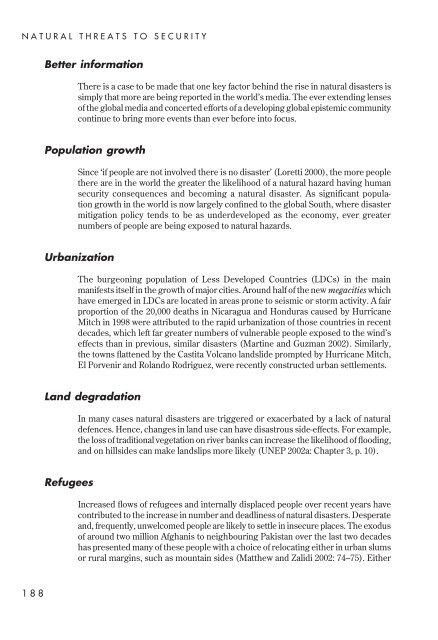Understanding global security - Peter Hough
Understanding global security - Peter Hough
Understanding global security - Peter Hough
You also want an ePaper? Increase the reach of your titles
YUMPU automatically turns print PDFs into web optimized ePapers that Google loves.
NATURAL THREATS TO SECURITY<br />
Better information<br />
There is a case to be made that one key factor behind the rise in natural disasters is<br />
simply that more are being reported in the world’s media. The ever extending lenses<br />
of the <strong>global</strong> media and concerted efforts of a developing <strong>global</strong> epistemic community<br />
continue to bring more events than ever before into focus.<br />
Population growth<br />
Since ‘if people are not involved there is no disaster’ (Loretti 2000), the more people<br />
there are in the world the greater the likelihood of a natural hazard having human<br />
<strong>security</strong> consequences and becoming a natural disaster. As significant population<br />
growth in the world is now largely confined to the <strong>global</strong> South, where disaster<br />
mitigation policy tends to be as underdeveloped as the economy, ever greater<br />
numbers of people are being exposed to natural hazards.<br />
Urbanization<br />
The burgeoning population of Less Developed Countries (LDCs) in the main<br />
manifests itself in the growth of major cities. Around half of the new megacities which<br />
have emerged in LDCs are located in areas prone to seismic or storm activity. A fair<br />
proportion of the 20,000 deaths in Nicaragua and Honduras caused by Hurricane<br />
Mitch in 1998 were attributed to the rapid urbanization of those countries in recent<br />
decades, which left far greater numbers of vulnerable people exposed to the wind’s<br />
effects than in previous, similar disasters (Martine and Guzman 2002). Similarly,<br />
the towns flattened by the Castita Volcano landslide prompted by Hurricane Mitch,<br />
El Porvenir and Rolando Rodriguez, were recently constructed urban settlements.<br />
Land degradation<br />
In many cases natural disasters are triggered or exacerbated by a lack of natural<br />
defences. Hence, changes in land use can have disastrous side-effects. For example,<br />
the loss of traditional vegetation on river banks can increase the likelihood of flooding,<br />
and on hillsides can make landslips more likely (UNEP 2002a: Chapter 3, p. 10).<br />
Refugees<br />
Increased flows of refugees and internally displaced people over recent years have<br />
contributed to the increase in number and deadliness of natural disasters. Desperate<br />
and, frequently, unwelcomed people are likely to settle in insecure places. The exodus<br />
of around two million Afghanis to neighbouring Pakistan over the last two decades<br />
has presented many of these people with a choice of relocating either in urban slums<br />
or rural margins, such as mountain sides (Matthew and Zalidi 2002: 74–75). Either<br />
188
















